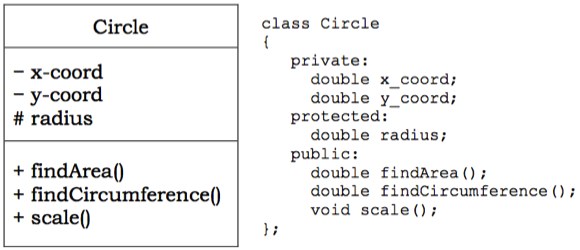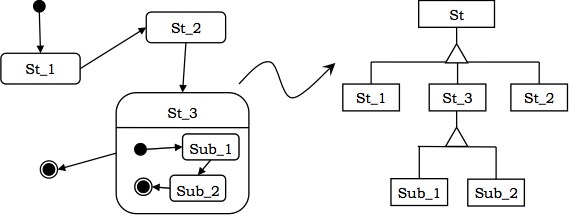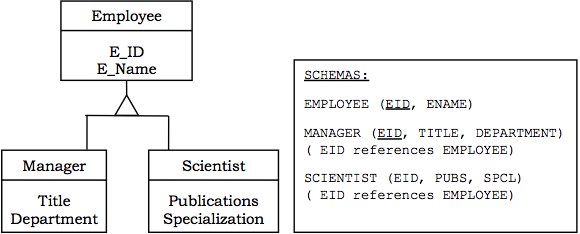
- OOAD - Home
- OOAD - Object Oriented Paradigm
- OOAD - Object Oriented Model
- OOAD - Object Oriented System
- OOAD - Object Oriented Principles
- OOAD - Object Oriented Analysis
- OOAD - Dynamic Modelling
- OOAD - Functional Modelling
- OOAD - UML Analysis Model
- OOAD - UML Basic Notations
- OOAD - UML Structural Diagrams
- OOAD - UML Behavioural Diagrams
- OOAD - Object Oriented Design
- OOAD - Implementation Strategies
- OOAD - Testing & Quality Assurance
OOAD - Implementation Strategies
Implementing an object-oriented design generally involves using a standard object oriented programming language (OOPL) or mapping object designs to databases. In most cases, it involves both.
Implementation using Programming Languages
Usually, the task of transforming an object design into code is a straightforward process. Any object-oriented programming language like C++, Java, Smalltalk, C# and Python, includes provision for representing classes. In this chapter, we exemplify the concept using C++.
The following figure shows the representation of the class Circle using C++.

Implementing Associations
Most programming languages do not provide constructs to implement associations directly. So the task of implementing associations needs considerable thought.
Associations may be either unidirectional or bidirectional. Besides, each association may be either onetoone, onetomany, or manytomany.
Unidirectional Associations
For implementing unidirectional associations, care should be taken so that unidirectionality is maintained. The implementations for different multiplicity are as follows −
Optional Associations − Here, a link may or may not exist between the participating objects. For example, in the association between Customer and Current Account in the figure below, a customer may or may not have a current account.

For implementation, an object of Current Account is included as an attribute in Customer that may be NULL. Implementation using C++ −
class Customer {
private:
// attributes
Current_Account c; //an object of Current_Account as attribute
public:
Customer() {
c = NULL;
} // assign c as NULL
Current_Account getCurrAc() {
return c;
}
void setCurrAc( Current_Account myacc) {
c = myacc;
}
void removeAcc() {
c = NULL;
}
};
Onetoone Associations − Here, one instance of a class is related to exactly one instance of the associated class. For example, Department and Manager have onetoone association as shown in the figure below.

This is implemented by including in Department, an object of Manager that should not be NULL. Implementation using C++ −
class Department {
private:
// attributes
Manager mgr; //an object of Manager as attribute
public:
Department (/*parameters*/, Manager m) { //m is not NULL
// assign parameters to variables
mgr = m;
}
Manager getMgr() {
return mgr;
}
};
Onetomany Associations − Here, one instance of a class is related to more than one instances of the associated class. For example, consider the association between Employee and Dependent in the following figure.

This is implemented by including a list of Dependents in class Employee. Implementation using C++ STL list container −
class Employee {
private:
char * deptName;
list <Dependent> dep; //a list of Dependents as attribute
public:
void addDependent ( Dependent d) {
dep.push_back(d);
} // adds an employee to the department
void removeDeoendent( Dependent d) {
int index = find ( d, dep );
// find() function returns the index of d in list dep
dep.erase(index);
}
};
Bi-directional Associations
To implement bi-directional association, links in both directions require to be maintained.
Optional or onetoone Associations − Consider the relationship between Project and Project Manager having onetoone bidirectional association as shown in the figure below.

Implementation using C++ −
Class Project {
private:
// attributes
Project_Manager pmgr;
public:
void setManager ( Project_Manager pm);
Project_Manager changeManager();
};
class Project_Manager {
private:
// attributes
Project pj;
public:
void setProject(Project p);
Project removeProject();
};
Onetomany Associations − Consider the relationship between Department and Employee having onetomany association as shown in the figure below.

Implementation using C++ STL list container
class Department {
private:
char * deptName;
list <Employee> emp; //a list of Employees as attribute
public:
void addEmployee ( Employee e) {
emp.push_back(e);
} // adds an employee to the department
void removeEmployee( Employee e) {
int index = find ( e, emp );
// find function returns the index of e in list emp
emp.erase(index);
}
};
class Employee {
private:
//attributes
Department d;
public:
void addDept();
void removeDept();
};
Implementing Associations as Classes
If an association has some attributes associated, it should be implemented using a separate class. For example, consider the onetoone association between Employee and Project as shown in the figure below.

Implementation of WorksOn using C++
class WorksOn {
private:
Employee e;
Project p;
Hours h;
char * date;
public:
// class methods
};
Implementing Constraints
Constraints in classes restrict the range and type of values that the attributes may take. In order to implement constraints, a valid default value is assigned to the attribute when an object is instantiated from the class. Whenever the value is changed at runtime, it is checked whether the value is valid or not. An invalid value may be handled by an exception handling routine or other methods.
Example
Consider an Employee class where age is an attribute that may have values in the range of 18 to 60. The following C++ code incorporates it −
class Employee {
private: char * name;
int age;
// other attributes
public:
Employee() { // default constructor
strcpy(name, "");
age = 18; // default value
}
class AgeError {}; // Exception class
void changeAge( int a) { // method that changes age
if ( a < 18 || a > 60 ) // check for invalid condition
throw AgeError(); // throw exception
age = a;
}
};
Implementing State Charts
There are two alternative implementation strategies to implement states in state chart diagrams.
Enumerations within Class
In this approach, the states are represented by different values of a data member (or set of data members). The values are explicitly defined by an enumeration within the class. The transitions are represented by member functions that change the value of the concerned data member.
Arrangement of Classes in a Generalization Hierarchy
In this approach, the states are arranged in a generalization hierarchy in a manner that they can be referred by a common pointer variable. The following figure shows a transformation from state chart diagram to a generalization hierarchy.

Object Mapping to Database System
Persistency of Objects
An important aspect of developing object-oriented systems is persistency of data. Through persistency, objects have longer lifespan than the program that created it. Persistent data is saved on secondary storage medium from where it can be reloaded when required.
Overview of RDBMS
A database is an ordered collection of related data.
A database management system (DBMS) is a collection of software that facilitates the processes of defining, creating, storing, manipulating, retrieving, sharing, and removing data in databases.
In relational database management systems (RDBMS), data is stored as relations or tables, where each column or field represents an attribute and each row or tuple represents a record of an instance.
Each row is uniquely identified by a chosen set of minimal attributes called primary key.
A foreign key is an attribute that is the primary key of a related table.
Representing Classes as Tables in RDBMS
To map a class to a database table, each attribute is represented as a field in the table. Either an existing attribute(s) is assigned as a primary key or a separate ID field is added as a primary key. The class may be partitioned horizontally or vertically as per requirement.
For example, the Circle class can be converted to table as shown in the figure below.

Schema for Circle Table: CIRCLE(CID, X_COORD, Y_COORD, RADIUS, COLOR) Creating a Table Circle using SQL command: CREATE TABLE CIRCLE ( CID VARCHAR2(4) PRIMARY KEY, X_COORD INTEGER NOT NULL, Y_COORD INTEGER NOT NULL, Z_COORD INTEGER NOT NULL, COLOR );
Mapping Associations to Database Tables
OnetoOne Associations
To implement 1:1 associations, the primary key of any one table is assigned as the foreign key of the other table. For example, consider the association between Department and Manager −

SQL commands to create the tables
CREATE TABLE DEPARTMENT ( DEPT_ID INTEGER PRIMARY KEY, DNAME VARCHAR2(30) NOT NULL, LOCATION VARCHAR2(20), EMPID INTEGER REFERENCES MANAGER ); CREATE TABLE MANAGER ( EMPID INTEGER PRIMARY KEY, ENAME VARCHAR2(50) NOT NULL, ADDRESS VARCHAR2(70), );
OnetoMany Associations
To implement 1:N associations, the primary key of the table in the 1-side of the association is assigned as the foreign key of the table at the N-side of the association. For example, consider the association between Department and Employee −

SQL commands to create the tables
CREATE TABLE DEPARTMENT ( DEPT_ID INTEGER PRIMARY KEY, DNAME VARCHAR2(30) NOT NULL, LOCATION VARCHAR2(20), ); CREATE TABLE EMPLOYEE ( EMPID INTEGER PRIMARY KEY, ENAME VARCHAR2(50) NOT NULL, ADDRESS VARCHAR2(70), D_ID INTEGER REFERENCES DEPARTMENT );
ManytoMany Associations
To implement M:N associations, a new relation is created that represents the association. For example, consider the following association between Employee and Project −

Schema for Works_On Table − WORKS_ON (EMPID, PID, HOURS, START_DATE)
SQL command to create Works_On association − CREATE TABLE WORKS_ON
( EMPID INTEGER, PID INTEGER, HOURS INTEGER, START_DATE DATE, PRIMARY KEY (EMPID, PID), FOREIGN KEY (EMPID) REFERENCES EMPLOYEE, FOREIGN KEY (PID) REFERENCES PROJECT );
Mapping Inheritance to Tables
To map inheritance, the primary key of the base table(s) is assigned as the primary key as well as the foreign key in the derived table(s).
Example
